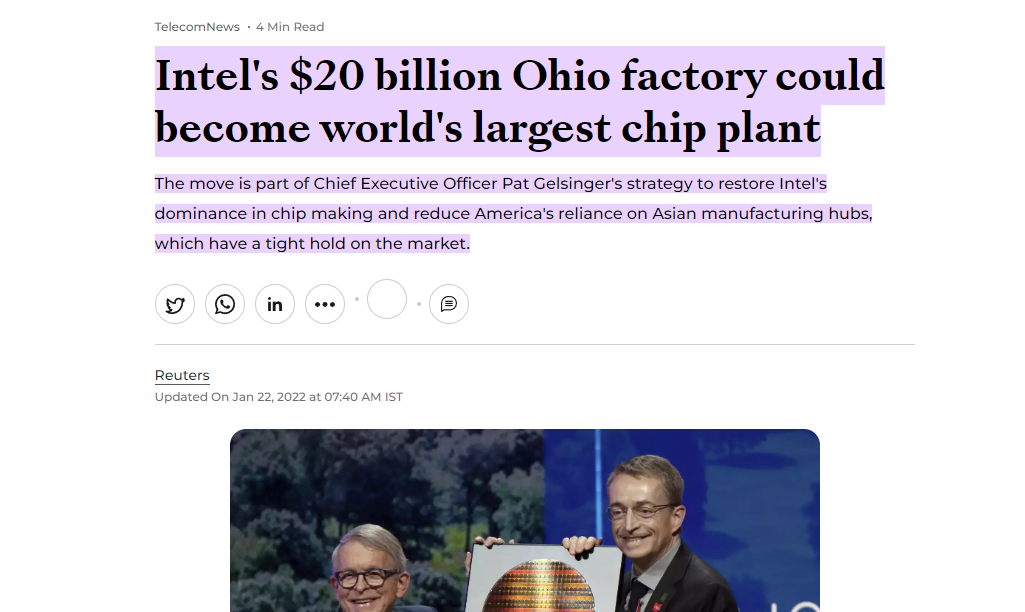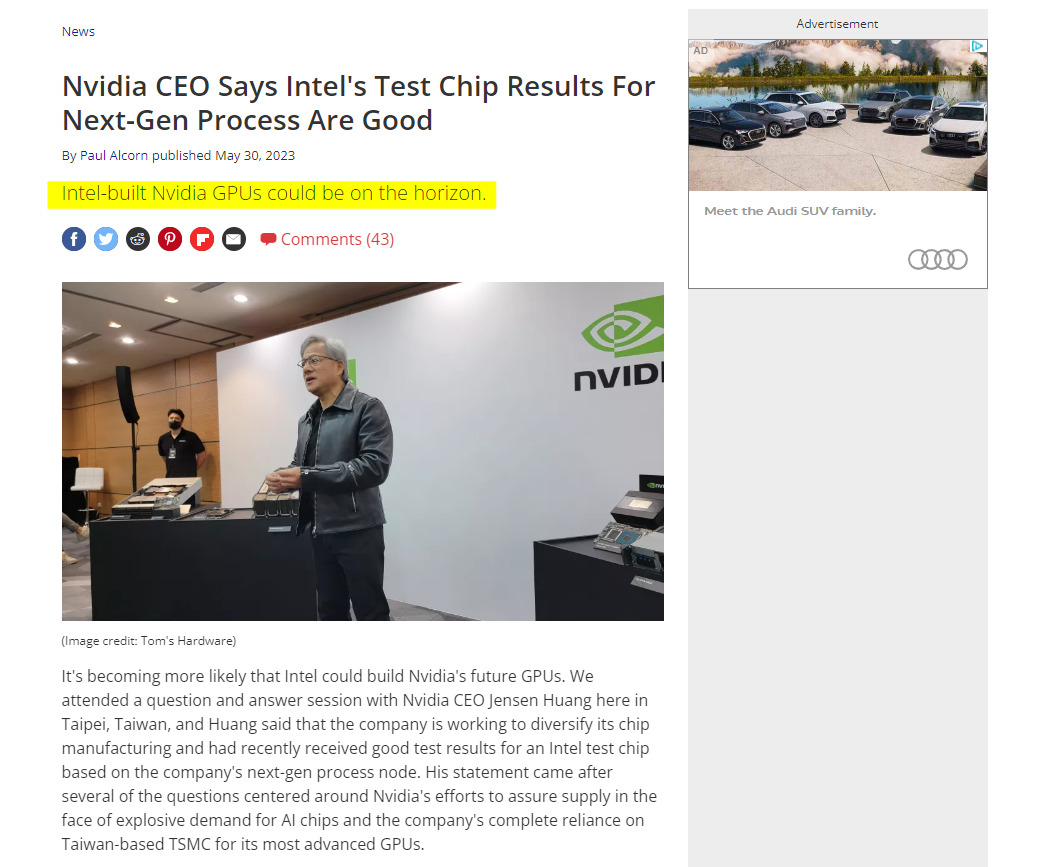
Eric Fry is out with another stock teaser pushing AI stocks and claiming if you "act now," there's "1,000% profit potential."
This time, he's pushing a chipmaker with a presence in America.
All of this is in his presentation with the title "The Coming $3 Trillion AI Panic."
However, he wants over $1700 to reveal the chipmaker he's talking about, but I have good news!
He left enough clues in the presentation to figure out the stock he's pushing, which I reveal below for free.
Additionally, I'll give you all the information you need on the stock so you can determine if it's a worthwhile investment or not.
Let's get started now!
The Coming $3 Trillion AI Panic Summary
Creator: Eric Fry
Newsletter: The Speculator ($1799 per year)
Stock: Intel

This teaser from Eric Fried focuses on America's push to bring chip manufacturing home and the effects AI will have on chips.
AI needs special kinds of chips, and big chipmakers are already seeing meaningful revenue from these chips.
Fry believes NVIDIA's stock is too high to really profit and instead recommends Intel.
Fry believes this stock has huge potential for a couple reasons, including a potential deal with NVIDIA and tax breaks for manufacturing in the United States.
However, this stock is going to require a lot of patience.
Intel saw revenue and earnings decrease significantly in 2022, and it's going to take years before they see meaningful profit from AI chips.
Overall, most analysts don't seem to share Fry's enthusiasm about Intel.
Keep reading if you want a more in-depth breakdown of the teaser and this stock.
Better opportunity: I've reviewed all the top places to get high return stock ideas. To see my favorite (which is extremely affordable), click below:
The Coming $3 Trillion AI Panic
Eric Fry is out with a new stock teaser that focuses on AI.
He recently released an AI teaser called Project Omega that was extremely popular.
My post revealing the stocks in that presentation was my most read post this year by far.
Well, Eric is trying to see if he can capture people's imaginations again, and this time he's focusing on chipmakers.
The main theme of this presentation is that AI is going to be big, and chipmakers are going to benefit big time from this trend.
The reason for this is quite simple: AI requires special GPUs and chips to function.
Every company is rushing to release AI products and hop on the AI trend.
So that means more chips are going to be made.
Fry's Pick Is American Made
Another big theme of this stock presentation is that the chipmaker Fry is recommending is going to manufacture in America.
The reason he's pushing American-made chips is that there are a lot of tax incentives to make chips in America.
According to Fry, American legislation offers 25% tax credits to companies that manufacture GPUs on US soil.
And according to Fry, a certain company will receive $20 billion in tax credits from the government.
This $20 billion can be used to develop new products, increase production, and build new plants, which Fry claims this company is doing.
Another reason Fry is pushing American chips is the potential for trouble in Taiwan.
Massive companies like NVIDIA get their GPUs from Taiwan Semiconductor, and any conflict Taiwan has with China would severely hurt NVIDIA.
As a result, NVIDIA is looking to get GPUs from an American manufacturer.
Recommended: The Best Place To Get Stock Picks
Intel Is The Stock Fry Is Talking About
There are a couple clues in the presentation that give away the stock Fry is talking about.
The first is that chipmakers could potentially build a $20 billion chip manufacturing plant in America, which would be the biggest in the world.
Here's an article detailing Intel's plan to do that in Ohio:

Another clue is that Fry claims NVIDIA wants American-made GPUs and could potentially get their GPUs from the company he's pitching.
This alludes to a potential deal with NVIDIA and Intel:

So I'm 100% confident that Intel is the company being pitched by Eric Fry here.
But is it a slamdunk investment like Fry claims?
Keep reading to get that answer.
Want The Best Stock Picks Weekly?
I've reviewed the best programs that do this.. to see my top pick, click below:
Analysts Are Lukewarm About Intel
The current state of Intel’s stock and what analysts think of the company are as follows:
- Intel’s stock performance has been underwhelming in the past year, as it has lagged behind its competitors and the broader market. It has gained only 5.9% in the past 12 months, compared to 28.4% for the S&P 500 and 38.8% for the NASDAQ-100.
- Intel’s stock performance has also been affected by its challenges in the semiconductor industry, such as the global chip shortage, the loss of market share to rivals like AMD and Nvidia, the delay in its 7-nanometer technology, and the increasing competition from Apple and other chip designers.
- Intel’s stock outlook is mixed, according to analysts’ forecasts and ratings. The average 12-month price target for Intel is $33.95, which implies a slight increase of 0.49% from its current price. However, the range of price targets is wide, from a low of $17 to a high of $46, reflecting the uncertainty and divergence of opinions about Intel’s future prospects.
- The average analyst rating for Intel is Hold, based on 6 buy ratings, 21 hold ratings, and 6 sell ratings. Some analysts are optimistic about Intel’s new leadership under CEO Pat Gelsinger, who has announced a bold strategy to revamp Intel’s manufacturing capabilities, expand its foundry services, and invest in new technologies like AI and 5G . Others are skeptical about Intel’s ability to catch up with its competitors and regain its innovation edge in the fast-changing semiconductor market .
So Fry seems to be much more enthusiastic about this company than many others.
Recommended: The Best Place To Get Stock Picks
Intel Had A Very Disapointing 2022
Intel had a disappointing year in 2022, as it faced multiple challenges in the semiconductor industry and struggled to keep up with its competitors. In this section, we will take a look at Intel’s earnings and revenue in 2022, and analyze the factors that contributed to its poor performance.
Intel’s Earnings and Revenue in 2022: The Numbers
According to its official financial reports, Intel reported $63.1 billion in total revenue for 2022, a 20% decline from its 2021 revenue of $78.9 billion. This was below the company’s own guidance of $65.5 billion and analysts’ expectations of $66.6 billion.
Intel’s revenue decline was mainly driven by its Client Computing Group (CCG), which makes chips for PCs, laptops, tablets, and smartphones. CCG revenue was $30.8 billion in 2022, down 25% from $41.1 billion in 2021.
CCG suffered from the global chip shortage, which affected the supply and demand of PC components, as well as the loss of market share to its rival AMD, which gained ground with its Ryzen and Epyc processors.
Intel’s other business segments also experienced revenue declines in 2022, except for its Network and Edge Group (NEG), which makes chips for network infrastructure, edge computing, and Internet of Things (IoT) devices.
NEG revenue was $7.9 billion in 2022, up 10% from $7.2 billion in 2021. NEG benefited from the growth of 5G and cloud computing, which increased the demand for Intel’s products and services.
Intel’s earnings per share (EPS) for 2022 was $1.94, down 64% from $5.30 in 2021. This was also below the company’s guidance of $2.00 and analysts’ expectations of $2.06.
Intel’s EPS decline was mainly due to its lower revenue, higher operating expenses, lower gross margin, and higher tax rate.
Intel’s gross margin for 2022 was 43.8%, down 12.1 percentage points from 55.8% in 2021. This was below the company’s guidance of 45% and analysts’ expectations of 46%.
Intel’s gross margin decline was mainly due to its lower revenue mix, higher costs associated with its delayed 7-nanometer technology, lower factory utilization, and increased competition.
Intel’s operating expenses for 2022 were $23 billion, up 11% from $20.7 billion in 2021. This was above the company’s guidance of $22 billion and analysts’ expectations of $21.8 billion.
Intel’s operating expenses increase was mainly due to its higher research and development (R&D) spending, as well as restructuring and impairment charges related to its strategic transformation.
Intel’s tax rate for 2022 was 45.7%, up 34.1 percentage points from 11.7% in 2021. This was above the company’s guidance of 15% and analysts’ expectations of 16%.
Intel’s tax rate increase was mainly due to a one-time charge of $4 billion related to the enactment of the U.S. Infrastructure Investment and Jobs Act (IIJA), which increased the corporate tax rate from 21% to 26.5%.
Intel’s Earnings and Revenue in 2022: The Analysis
Intel’s earnings and revenue in 2022 reflected a year of challenges and transformation for the company, as it faced several headwinds in the semiconductor industry and embarked on a bold strategy to revamp its manufacturing capabilities, expand its foundry services, and invest in new technologies.
Some of the challenges that Intel faced in 2022 were:
- The global chip shortage, which affected the supply and demand of PC components, as well as other industries that rely on semiconductors, such as automotive, consumer electronics, industrial, and medical.
- The loss of market share to AMD, which gained ground with its Ryzen and Epyc processors that offered better performance, power efficiency, and price than Intel’s Core and Xeon processors.
- The delay in its 7-nanometer technology, which put Intel behind its competitors like TSMC and Samsung that were already producing chips using more advanced processes.
- The increasing competition from Apple and other chip designers that used ARM-based architectures, which offered lower power consumption and higher integration than Intel’s x86-based architectures.
Some of the transformation initiatives that Intel undertook in 2022 were:
- The announcement of its IDM 2.0 strategy, which aimed to leverage its internal manufacturing capabilities, expand its external foundry partnerships, and offer its foundry services to other chip customers.
- The launch of its 11th-generation Core processors, codenamed Tiger Lake, which featured its 10-nanometer SuperFin technology and integrated Xe graphics.
- The introduction of its 3rd-generation Xeon Scalable processors, codenamed Ice Lake, which featured its 10-nanometer Sunny Cove technology and supported PCIe Gen4 and DDR4-3200 memory.
- The acquisition of Habana Labs, a company that specialized in AI accelerators, and the integration of its products into Intel’s AI portfolio.
- The investment of $20 billion to build two new fabs in Arizona, and the plan to invest $80 billion more to build additional fabs in the U.S. and Europe over the next decade.
Intel’s Earnings and Revenue in 2022: The Outlook
Intel’s earnings and revenue outlook for 2023 is mixed, according to its own guidance and analysts’ forecasts. The company expects to generate $45 billion in revenue for 2023, down 29% from 2022.
It also expects to report a loss per share of $0.80 for 2023, compared to a profit per share of $1.94 in 2022. However, these numbers include the impact of the planned sale of its NAND memory business to SK Hynix, which is expected to close in late 2022 or early 2023.
Excluding this impact, Intel expects to generate $55 billion in revenue for 2023, down 13% from 2022. It also expects to report a profit per share of $0.15 for 2023, down 92% from 2022.
Analysts have a slightly more optimistic view of Intel’s earnings and revenue outlook for 2023. The average consensus estimate for Intel’s revenue for 2023 is $56.1 billion, down 11% from 2022. The average consensus estimate for Intel’s EPS for 2023 is $0.28, down 86% from 2022.
Intel’s earnings and revenue outlook for 2023 reflects the continued challenges and uncertainties that the company faces in the semiconductor industry, as well as the potential opportunities and benefits that its transformation strategy may bring in the long term.
Intel will need to overcome the global chip shortage, regain its market share and innovation edge, execute its IDM 2.0 strategy, and deliver on its product roadmap to achieve its financial goals and create shareholder value.
AI And NVIDIA's Impact On Intel's Future
Intel is one of the world’s largest and most influential technology companies, but it has been lagging behind its rivals in the fast-growing and lucrative artificial intelligence chip market.
AI chips are specialized processors that can handle complex tasks such as machine learning, computer vision, natural language processing, and speech recognition. They are in high demand for various applications such as cloud computing, gaming, autonomous vehicles, and smart devices.
Here we will examine how AI could affect Intel’s stock price in both positive and negative ways, depending on how well the company can compete with its competitors in the AI chip market.
We will also analyze how a potential deal with Nvidia, the leader in the AI chip market, could impact Intel’s stock price.
The Positive Scenario: Intel Catches Up with Nvidia
Intel has been losing market share and innovation edge to Nvidia and AMD in the CPU and GPU markets, which are still its main sources of revenue. However, Intel has not given up on the AI chip market and has announced several initiatives to expand its AI portfolio and capabilities.
For instance, Intel recently launched its Data Center GPU Max series, which are designed to accelerate AI workloads in data centers.
These GPUs are based on Intel’s Xe architecture and can deliver up to 10 times faster performance than its previous generation GPUs. Intel also acquired Habana Labs, a company that specialized in AI accelerators, and integrated its products into Intel’s AI portfolio.
Moreover, Intel revealed some details about its upcoming H100 GPU, which will be based on its new Hopper microarchitecture and will target high-performance computing and AI applications.
These products and technologies could help Intel gain market share and revenue in the fast-growing AI chip market, which is expected to reach $91.18 billion by 2025.
If Intel can successfully develop and launch its own AI chips that can match or surpass the performance, power efficiency, and price of its competitors, it could boost its stock price by attracting more customers and investors.
The Negative Scenario: Intel Falls Behind Nvidia
On the other hand, Intel faces several challenges and uncertainties in the semiconductor industry that could hamper its progress and growth in the AI chip market.
For example, Intel has faced a global chip shortage that has affected the supply and demand of PC components, as well as other industries that rely on semiconductors.
Intel has also faced delays in its 7-nanometer technology, which has put it behind its competitors like TSMC and Samsung that are already producing chips using more advanced processes.
Furthermore, Intel has faced increasing competition from Apple and other chip designers that use ARM-based architectures, which offer lower power consumption and higher integration than Intel’s x86-based architectures.
These factors have eroded Intel’s market share and innovation edge in the CPU market, which is still its main source of revenue.
If Intel cannot offer competitive AI chips that can run on its CPUs or complement them, it could lose more customers and revenue to Nvidia and AMD, which have been dominating the GPU market.
Nvidia has been leading the AI chip market with its powerful GPUs that can handle various AI workloads such as generative AI and machine learning. Nvidia has also been expanding its product portfolio with new offerings such as the Grace CPU, which is designed for large-scale neural network systems.
If Intel fails to catch up with Nvidia or loses its existing customers to them, it could hurt its stock price by disappointing investors and analysts.
The Mixed Scenario: Intel Partners with Nvidia
A potential deal with Nvidia could also affect Intel’s stock price in different ways. According to Reuters, Nvidia has confirmed that it is “very interested in exploring” the possibility of using Intel’s foundries to produce Nvidia chips. This could have several implications for both companies.
On one hand, a deal with Nvidia could benefit Intel by increasing its foundry revenue and utilization rate. Intel has recently relaunched its foundry business and announced plans to invest $20 billion to build two new fabs in Arizona and $80 billion more to build additional fabs in the U.S. and Europe over the next decade.
By offering its foundry services to Nvidia, Intel could gain a major customer that has a strong demand for high-performance chips. This could also improve Intel’s relationship with Nvidia and potentially lead to more collaborations in the future.
On the other hand, a deal with Nvidia could also pose some risks for Intel by strengthening its rival’s position and reducing its own differentiation.
By using Intel’s foundries, Nvidia could gain access to advanced manufacturing technologies that could enhance its chip performance and efficiency. This could give Nvidia an edge over Intel in the AI chip market, as well as other markets such as gaming, data center
Recommended: The Best Place To Get Stock Picks
Wrapping Things Up
So that's the end of my post detailing Eric Fry's stock teaser.
Eric is once again recommending stocks to capitalize on AI, and this time he's recommending Intel.
He claims tax breaks and deals with Nvidia will ensure the stock rises.
But analysts seem to be pretty skeptical about this.
Most seem to think the stock is a hold right now and aren't necessarily recommending people buy it.
There's potential here, but there are also a lot of hurdles.
Intel has to do a lot right to catch up to Nvidia and AMD.
What do you think about Intel and the stock's future?
Comment below and let me know!
Get High Return Stocks!
I've reviewed 100+ stock picking services. To learn more about my favorite, click below: